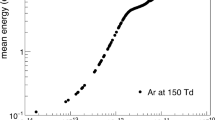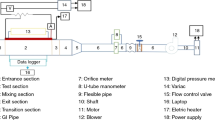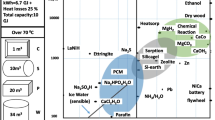Abstract
Radiation is an important means of heat transfer inside an electric arc furnace (EAF). To gain insight into the complex processes of heat transfer inside the EAF vessel, not only radiation from the surfaces but also emission and absorption of the gas phase and the dust cloud need to be considered. Furthermore, the radiative heat exchange depends on the geometrical configuration which is continuously changing throughout the process. The present paper introduces a system model of the EAF which takes into account the radiative heat transfer between the surfaces and the participating medium. This is attained by the development of a simplified geometrical model, the use of a weighted-sum-of-gray-gases model, and a simplified consideration of dust radiation. The simulation results were compared with the data of real EAF plants available in literature.












Similar content being viewed by others
Abbreviations
- Nu:
-
Nusselt number
- Pr:
-
Prandtl number
- Re:
-
Reynolds number
- \( \bar{\alpha } \) :
-
Geometric-mean absorption coefficient
- ε :
-
Emissivity
- θ :
-
Angle measured from normal of surface (rad)
- κ :
-
Extinction coefficient
- λ :
-
Wave length (m)
- ρ :
-
Density (kg m−3)
- σ :
-
Stefan-Boltzmann constant
- \( \bar{\tau } \) :
-
Geometric-mean transmission coefficient
- a :
-
Absorption coefficient (m−1)
- A :
-
Area (m2)
- B d :
-
Dust load (kg m−3)
- c :
-
Speed of light (m s−1)
- c, c v :
-
Specific heat capacity (J kg−1 K−1)
- C :
-
Parameter of mean beam length
- d, D :
-
Diameter (m)
- e :
-
Emissive power (W m−2)
- F :
-
View factor
- h :
-
Planck constant (J s)
- h :
-
Specific enthalpy (J kg−1)
- h 12 :
-
Coefficient of heat transfer (W m−2 K−1)
- H :
-
Height (m)
- i λ :
-
Spectral radiation intensity (W m−2 µm−1 sr−1)
- k :
-
Boltzmann constant (J K−1)
- k 12 :
-
Pressure loss coefficient
- l :
-
Length (m)
- L e :
-
Mean beam length (m)
- m :
-
Mass (kg)
- \( \dot{m} \) :
-
Mass flow rate (kg s−1)
- m λ :
-
Complex refractive index
- n :
-
Normal direction
- n λ :
-
Refractive index
- N :
-
Number of elements
- p :
-
Pressure (Pa)
- P :
-
Power (W)
- q :
-
Energy flux (W m−2)
- \( \dot{Q} \) :
-
Heat flow rate (W)
- Q λ,e/s/a :
-
Extinction/scattering/absorption efficiency
- r :
-
Radius (m)
- r, z, φ :
-
Cylindrical coordinates
- s :
-
Share
- S :
-
Path of radiation (m)
- t:
-
Time (s)
- T :
-
Temperature (K)
- V :
-
Volume (m3)
- w :
-
Weight of gray gas,
- x :
-
Mass fraction
- x p :
-
Size parameter of Mie theory
- Y :
-
Molar fraction
- a:
-
Arc
- b:
-
Basket
- bl:
-
Black body condition
- conv:
-
Convective
- cw:
-
Cooling water
- d:
-
Dust
- g:
-
Gas
- high:
-
High dust model
- in:
-
Incoming
- l:
-
Liquid phase/melt
- low:
-
Low dust model
- out:
-
Outgoing
- p:
-
Particle
- r:
-
Roof
- rad:
-
Radiation
- ref:
-
Reference value
- rv:
-
Radiation volume
- s:
-
Solid phase/scrap
- sl:
-
Slag
- v:
-
Vessel
- w:
-
Wall
- CFD:
-
Computational fluid dynamics
- DC:
-
Direct current
- EAF:
-
Electric arc furnace
- WSGG:
-
Weighted sum of gray gases
References
F. Opitz and P. Treffinger: Metall. Mater. Trans. B, 2016, vol. 47, pp. 1489–1503, DOI:10.1007/s11663-015-0573-x.
R. D. M. MacRosty and C. L. E. Swartz: Ind. Eng. Chem. Res., 2005, vol. 44, pp. 8067–83, DOI:10.1021/ie050101b.
V. Logar and I. Škrjanc: ISIJ Int., 2012, vol. 52, pp. 1225–32, DOI:10.2355/isijinternational.52.1225.
T. Meier, A. H. Kolagar, T. Echterhof, and H. Pfeifer, In: 11th European Electric Steelmaking Conference, Venice, Italy, 2016.
J. Alexis, M. Ramirez, G. Trapaga, and P. Jönsson: ISIJ Int., 2000, vol. 40, pp. 1089–97.
Guo D., Irons G.A.: Third International Conference on CFD in the Minerals and Process Industries, Melbourne. Australia, 2003, pp. 223–28.
Jordan G., Sheridan A.T., Montgomery R.W., Danby M.: Basic properties of high intensity electric arcs used in steelmaking, Steel research report 6210.93/8/801Commission of the European Communities, 1976.
B. Bowman and K. Krüger: Arc Furnace Physics, Verlag Stahleisen, Düsseldorf, 2009.
V. Logar, D. Dovžan, and I. Škrjanc: ISIJ Int., 2012, vol. 52, pp. 402–12, DOI:10.2355/isijinternational.52.402.
F. Opitz, P. Treffinger, J. Wöllenstein, and R. Schweikle, In: 11th European Electric Steelmaking Conference, Venice, Italy, 2016.
Howell J.R.: A Catalog of Radiation Heat Transfer Configuration Factors, University of Texas, 2016. http://www.thermalradiation.net/indexCat.html, Last visited: 2016-06-08.
R. Siegel and J. R. Howell: Thermal Radiation Heat Transfer, 4th ed., Taylor & Francis, New York/London, 2002.
R. Johansson, B. Leckner, K. Andersson, and F. Johnsson: Combust. Flame, 2011, vol. 158, pp. 893–901, DOI:10.1016/j.combustflame.2011.02.001.
Richter W., Görner K.: in VDI Heat Atlas, VDI-Gesellschaft Verfahrenstechnik und Chemieingenieurwesen (GVC) (ed.), 2010, pp. 1001–12.
Mätzler C.: MATLAB Functions for Mie Scattering and Absorption, University of Bern, 2002. http://omlc.org/software/mie, Last visited: 2016-06-02.
M. Neubronner: Strahlungswärmeübertragung von Aschepartikeln aus Kohlefeuerungen, VDI Verlag, Düsseldorf, 2000.
M. Alizadeh and M. Momeni: Constr. Build. Mater., 2016, vol. 112, pp. 1041–45, DOI:10.1016/j.conbuildmat.2016.03.011.
M. C. da Silva, A. M. Bernardes, C. P. Bergmann, J. A. S. Tenorio, and D. C. R. Espinosa: Ironmaking Steelmaking, 2008, vol. 35, pp. 315–20, DOI:10.1179/030192307X232936.
M. C. Mantovani, C. Takano, and P. M. Büchler: Ironmaking Steelmaking, 2004, vol. 31, pp. 325–32, DOI:10.1179/030192304225018163.
Rizescu C.-Z., Bacinschi Z., Stoian E.-V., Poinescu A.-A.:4th WSEAS International Conference on Waste Management, Water Pollution, Air Pollution, Indoor Climate (WWAI ‘10), Sousse, Tunisia. 2010, pp. 139–43.
H. Yoshikawa and S. Adachi: Jpn. J. Appl. Phys., 1997, vol. 36, pp. 6237–43.
Gnielinski V.: in VDI Heat Atlas, VDI-Gesellschaft Verfahrenstechnik und Chemieingenieurwesen (GVC) (ed.), 2010, pp. 693–99.
V. Logar, D. Dovžan, and I. Škrjanc: ISIJ Int., 2011, vol. 51, pp. 382–91, DOI:10.2355/isijinternational.51.382.
Acknowledgments
This research project is funded by the German Federal Ministry of Education and Research (BMBF) within the framework concept ‘IngenieurNachwuchs‘ (Grant Number 03FH00212).
Author information
Authors and Affiliations
Corresponding author
Additional information
Manuscript submitted February 20, 2017.
Rights and permissions
About this article
Cite this article
Opitz, F., Treffinger, P. & Wöllenstein, J. Modeling of Radiative Heat Transfer in an Electric Arc Furnace. Metall Mater Trans B 48, 3301–3315 (2017). https://doi.org/10.1007/s11663-017-1078-6
Received:
Published:
Issue Date:
DOI: https://doi.org/10.1007/s11663-017-1078-6




